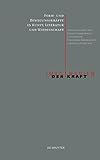Form- und Bewegungskräfte in Kunst, Literatur und Wissenschaft / hrsg. von Frank Fehrenbach, Lutz Hengst, Frederike Middelhoff, Cornelia Zumbusch.
Material type: TextSeries: Imaginarien der Kraft ; 2Publisher: Berlin ; Boston : De Gruyter, [2021]Copyright date: ©2021Description: 1 online resource (350 p.)Content type:
TextSeries: Imaginarien der Kraft ; 2Publisher: Berlin ; Boston : De Gruyter, [2021]Copyright date: ©2021Description: 1 online resource (350 p.)Content type: - 9783110743937
- 9783110743968
- online - DeGruyter
- Issued also in print.
| Item type | Current library | Call number | URL | Status | Notes | Barcode | |
|---|---|---|---|---|---|---|---|
 eBook
eBook
|
Biblioteca "Angelicum" Pont. Univ. S.Tommaso d'Aquino Nuvola online | online - DeGruyter (Browse shelf(Opens below)) | Online access | Not for loan (Accesso limitato) | Accesso per gli utenti autorizzati / Access for authorized users | (dgr)9783110743968 |
Browsing Biblioteca "Angelicum" Pont. Univ. S.Tommaso d'Aquino shelves, Shelving location: Nuvola online Close shelf browser (Hides shelf browser)
Frontmatter -- Inhaltsverzeichnis -- Vorwort -- Form- und Bewegungskräfte -- Kraftreflexionen: Natur, Geschichte, Ästhetik -- Biologische Autonomie -- Natur, ‚Kraft‘ und Geschichte -- Handelnde Kräfte -- Formkräfte in der Einfühlungsästhetik um 1900 -- Bewegungskräfte in den Künsten -- Die Form musikalischer Bewegungskraft nach 1600 -- Elevation – Erhebung – Schweben -- Wandern, winden, sprossen, steigen -- Plötzliches Italien -- Transformationen -- Liquid Matters -- Formkräfte: Ökonomien, Organismen, Techniken -- Die Pflanze als Erfinder -- Technologie im Sinne Leonardos? -- Das Unding der Kraftverschwendung -- Die unheimlichen Kräfte der Natur in ‚spekulativen Seinserzählungen‘ von der Romantik bis zur Gegenwart -- BILDNACHWEISE
restricted access online access with authorization star
http://purl.org/coar/access_right/c_16ec
Dealing with forces is part of the basic inventory of artistic processes. In giving shape and movement to material, such forces are manifested in a specific form; as push and pull, for example, as heaviness and lightness, but also as attachment and dissolution. The articles in the book examine notions of formative and motive forces using examples from art, music, dance, theater, photography and literature. The questions posed not only cover how historical notions of force (such as energeia and vis from ancient rhetoric) are adopted, taken further, and correlated with mechanically, metaphysically and organologically based concepts of force, but also how, in the examination of form and movement, the inherent concepts of force are manifested or presented in a new light.
Der Umgang mit Kräften gehört zum Grundinventar künstlerischer Verfahren. Im formgebenden und bewegenden Zugriff auf Material prägen sie sich konkret aus, etwa als Zug und Stoß, Schwere und Levitation, aber auch als Bindung und Auflösung. Die Beiträge des Bandes untersuchen Vorstellungen von Form- und Bewegungskräften anhand von Beispielen aus Kunst, Musik, Tanz, Theater, Fotografie und Literatur. Gefragt wird dabei nicht nur, wie historische Kraftbegriffe (etwa energeia und vis aus der antiken Rhetorik) aufgenommen, weiterentwickelt und zu mechanischen, metaphysischen und organologisch fundierten Kraftkonzepten in Bezug gesetzt werden. Auch erkunden die Beiträge, wie in der Beschäftigung mit Form und Bewegung je eigene Kraftkonzepte hervorgebracht oder neu perspektiviert werden.
Issued also in print.
Mode of access: Internet via World Wide Web.
In German.
Description based on online resource; title from PDF title page (publisher's Web site, viewed 28. Feb 2023)









